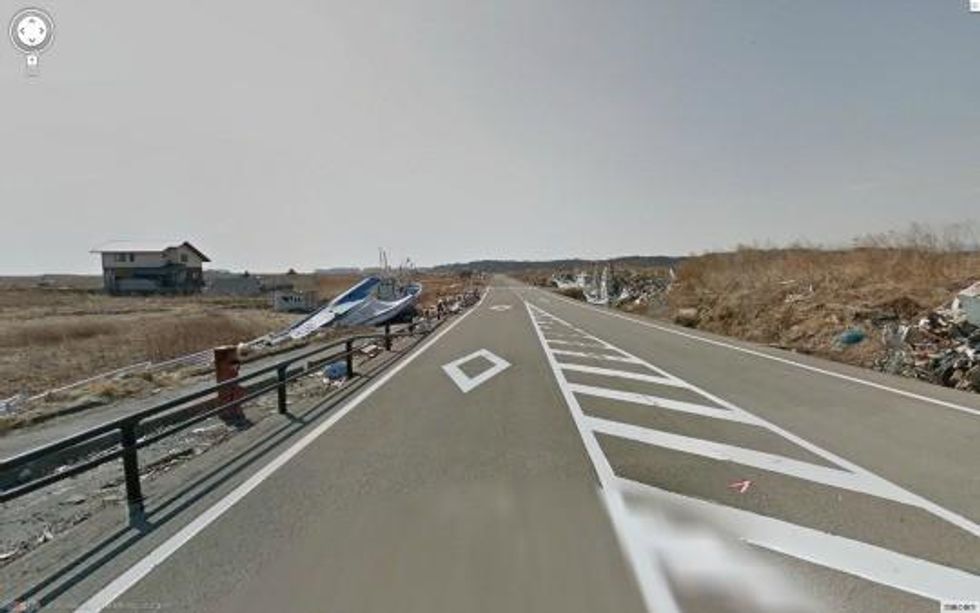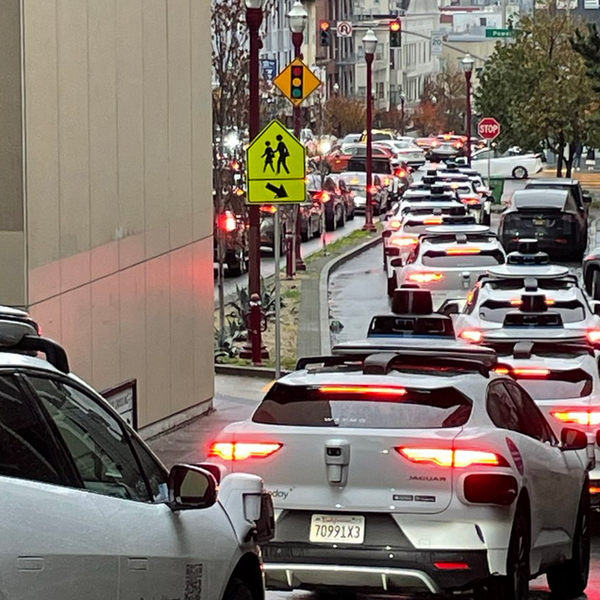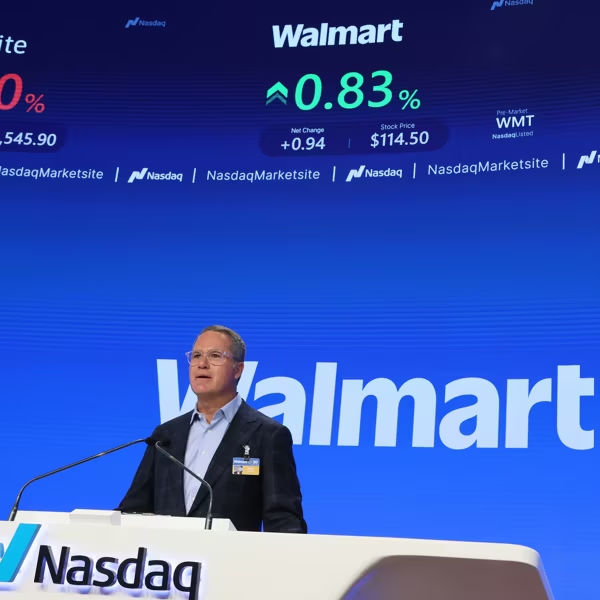Ghost Towns Left in Fukushima's Wake Shown in Google Street View
'A permanent record of what happened' in the nuclear disaster

Through the technology, one can now take a virtual stroll down the devastated and largely deserted streets of a once active seaside community, the city of Namie.
Namie was formerly home to 21,000 residents who have been unable to return since the disaster two years ago.
The streets remain mostly empty, barring rubble and litter left behind, a testament to the vast dangers of the nuclear industry.
"Those of us in the older generation feel that we received this town from our forbearers, and we feel great pain that we cannot pass it down to our children," Namie Mayor Tamotsu Baba said.
"We want this Street View imagery to become a permanent record of what happened to Namie-machi in the earthquake, tsunami and nuclear disaster."
Google has been documenting the damage from the disaster over the past two years on the site, "Mirai e no kioku" --"memories for the future" -- with Street View footage of several cities surrounding Fukushima from before and after the tsunami.
[iframe https://maps.google.com/maps?q=%E8%AB%8B%E6%88%B8%E6%BC%81%E6%B8%AF,+Namie,+Fukushima+Prefecture,+Japan&hl=ja&ie=UTF8&sll=37.0625,-95.677068&sspn=38.775203,75.9375&oq=%E8%AB%8B%E6%88%B8&hq=%E8%AB%8B%E6%88%B8%E6%BC%81%E6%B8%AF,&hnear=%E6%97%A5%E6%9C%AC,+%E7%A6%8F%E5%B3%B6%E7%9C%8C%E5%8F%8C%E8%91%89%E9%83%A1%E6%B5%AA%E6%B1%9F%E7%94%BA&t=m&layer=c&cbll=37.484227,141.030021&panoid=B5J2mSWdnESMG_EO4l28pg&cbp=13,170.52,,0,0.21≪=37.481167,141.030035&spn=0.010693,0.024118&z=15&source=embed&output=svembed height=314 width=460]
_______________________
An Urgent Message From Our Co-Founder
Dear Common Dreams reader, The U.S. is on a fast track to authoritarianism like nothing I've ever seen. Meanwhile, corporate news outlets are utterly capitulating to Trump, twisting their coverage to avoid drawing his ire while lining up to stuff cash in his pockets. That's why I believe that Common Dreams is doing the best and most consequential reporting that we've ever done. Our small but mighty team is a progressive reporting powerhouse, covering the news every day that the corporate media never will. Our mission has always been simple: To inform. To inspire. And to ignite change for the common good. Now here's the key piece that I want all our readers to understand: None of this would be possible without your financial support. That's not just some fundraising cliche. It's the absolute and literal truth. We don't accept corporate advertising and never will. We don't have a paywall because we don't think people should be blocked from critical news based on their ability to pay. Everything we do is funded by the donations of readers like you. Will you donate now to help power the nonprofit, independent reporting of Common Dreams? Thank you for being a vital member of our community. Together, we can keep independent journalism alive when it’s needed most. - Craig Brown, Co-founder |
Jacob Chamberlain is a former staff writer for Common Dreams. He is the author of Migrant Justice in the Age of Removal. His website is www.jacobpchamberlain.com.

Through the technology, one can now take a virtual stroll down the devastated and largely deserted streets of a once active seaside community, the city of Namie.
Namie was formerly home to 21,000 residents who have been unable to return since the disaster two years ago.
The streets remain mostly empty, barring rubble and litter left behind, a testament to the vast dangers of the nuclear industry.
"Those of us in the older generation feel that we received this town from our forbearers, and we feel great pain that we cannot pass it down to our children," Namie Mayor Tamotsu Baba said.
"We want this Street View imagery to become a permanent record of what happened to Namie-machi in the earthquake, tsunami and nuclear disaster."
Google has been documenting the damage from the disaster over the past two years on the site, "Mirai e no kioku" --"memories for the future" -- with Street View footage of several cities surrounding Fukushima from before and after the tsunami.
[iframe https://maps.google.com/maps?q=%E8%AB%8B%E6%88%B8%E6%BC%81%E6%B8%AF,+Namie,+Fukushima+Prefecture,+Japan&hl=ja&ie=UTF8&sll=37.0625,-95.677068&sspn=38.775203,75.9375&oq=%E8%AB%8B%E6%88%B8&hq=%E8%AB%8B%E6%88%B8%E6%BC%81%E6%B8%AF,&hnear=%E6%97%A5%E6%9C%AC,+%E7%A6%8F%E5%B3%B6%E7%9C%8C%E5%8F%8C%E8%91%89%E9%83%A1%E6%B5%AA%E6%B1%9F%E7%94%BA&t=m&layer=c&cbll=37.484227,141.030021&panoid=B5J2mSWdnESMG_EO4l28pg&cbp=13,170.52,,0,0.21≪=37.481167,141.030035&spn=0.010693,0.024118&z=15&source=embed&output=svembed height=314 width=460]
_______________________
Jacob Chamberlain is a former staff writer for Common Dreams. He is the author of Migrant Justice in the Age of Removal. His website is www.jacobpchamberlain.com.

Through the technology, one can now take a virtual stroll down the devastated and largely deserted streets of a once active seaside community, the city of Namie.
Namie was formerly home to 21,000 residents who have been unable to return since the disaster two years ago.
The streets remain mostly empty, barring rubble and litter left behind, a testament to the vast dangers of the nuclear industry.
"Those of us in the older generation feel that we received this town from our forbearers, and we feel great pain that we cannot pass it down to our children," Namie Mayor Tamotsu Baba said.
"We want this Street View imagery to become a permanent record of what happened to Namie-machi in the earthquake, tsunami and nuclear disaster."
Google has been documenting the damage from the disaster over the past two years on the site, "Mirai e no kioku" --"memories for the future" -- with Street View footage of several cities surrounding Fukushima from before and after the tsunami.
[iframe https://maps.google.com/maps?q=%E8%AB%8B%E6%88%B8%E6%BC%81%E6%B8%AF,+Namie,+Fukushima+Prefecture,+Japan&hl=ja&ie=UTF8&sll=37.0625,-95.677068&sspn=38.775203,75.9375&oq=%E8%AB%8B%E6%88%B8&hq=%E8%AB%8B%E6%88%B8%E6%BC%81%E6%B8%AF,&hnear=%E6%97%A5%E6%9C%AC,+%E7%A6%8F%E5%B3%B6%E7%9C%8C%E5%8F%8C%E8%91%89%E9%83%A1%E6%B5%AA%E6%B1%9F%E7%94%BA&t=m&layer=c&cbll=37.484227,141.030021&panoid=B5J2mSWdnESMG_EO4l28pg&cbp=13,170.52,,0,0.21≪=37.481167,141.030035&spn=0.010693,0.024118&z=15&source=embed&output=svembed height=314 width=460]
_______________________

